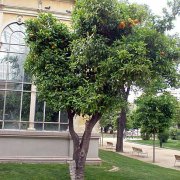Care of the tree Citrus x aurantium or Bitter orange |
|
The genus Citrus, family Rutaceae, includes shrubs and trees native to Asia, Melanesia and Australia. Some species and hybrids are: Citrus x aurantium, Citrus maxima, Citrus x limon, Citrus reticulata, Citrus x paradisi, Citrus medica, Citrus x sinensis, Citrus micrantha, Citrus glauca. Common names: Bitter orange, Seville orange, Marmalade orange, Sour orange, Bigarade orange. This species is native to Southeast Asia. They are evergreen trees with a rounded crown and thorny branches that reach 6 meters (19.68 feet) in height. The leaves are leathery, large and oval-elliptical in shape. The scented flowers are white and appear solitary or in corymbs. They bloom from mid-fall to early spring. The fruits (bitter oranges) are not edible due to the bitter taste but they are used to make jams and with their juice you can marinate meats. Bitter orange is used in small and medium gardens, in streets and public parks. It's also used in perfumery and in the pharmaceutical industry. Citrus aurantium needs full sun or light shade exposure and a warm climate; does not resist frost. The soil must be light, well drained and contain organic matter. Seville orange requires medium watering, waiting until the substrate has almost dried before watering. Fertilize with compost or manure in fall and with slow-release mineral fertilizer in winter. Prune lightly in early fall to maintain a rounded crown. Sour orange is quite resistant to the usual pests and diseases. Marmalade orange propagates by seeds sown in the nursery, in autumn or winter, by previously soaking them for 48 hours. |
Image of the tree Citrus x aurantium or Bitter orange |
Find plants
Citrus x aurantium or Bitter orange | Care and Growing
© 2025 FavThemes



